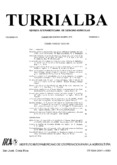| dc.description.abstract | Twelve plantations of Toona ciliata, ranging from two to seven years of age, were studied in an effort to re-evaluate the potential of the species for industrial forest tree plantations in Turrialba, Costa Rica. Branching, wood quality, coppicing, site sensivity and growth were the principal aspects studied. The conclusions reached indicate that, with certain reservations, Toona ciliata var. australis could become an important exotic cabinet wood species for a plantation program in Turrialba and similar areas, the growth rate is excellent on optimum sites, at least through the fourth year. Toona us not too site specific, although site quality certainly effects growth. The occurrence and effect of branches can be controlled silviculturally. Phytosanitary probleMON are not yet an important factor in Turrialba. Thinning results in fast-growing well-formed coppice shoots. The wood of fast-grown steMON seven years old or less is of very light density, but wood of older steMON, it is speculatede, would perhaps be of satisfactory quality | es_ES |


